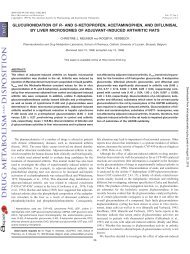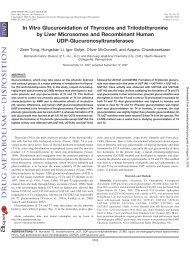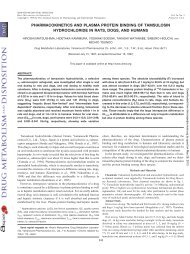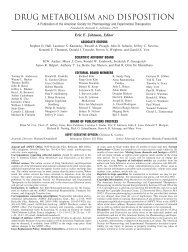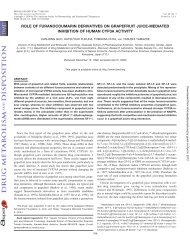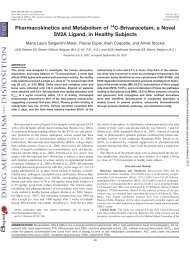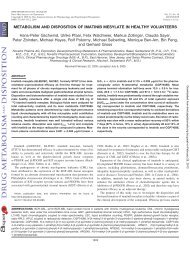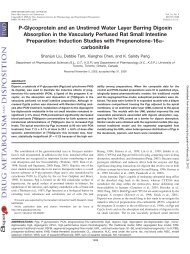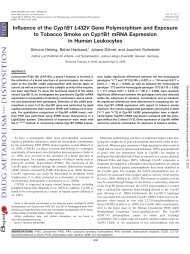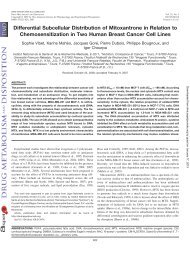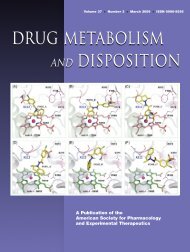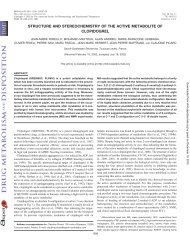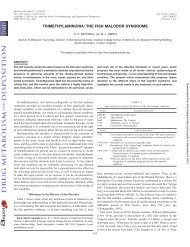development of an in vitro screening model for the biosynthesis of ...
development of an in vitro screening model for the biosynthesis of ...
development of an in vitro screening model for the biosynthesis of ...
You also want an ePaper? Increase the reach of your titles
YUMPU automatically turns print PDFs into web optimized ePapers that Google loves.
FIG. 7.Correlation between <strong>the</strong> extent <strong>of</strong> covalent b<strong>in</strong>d<strong>in</strong>g (prote<strong>in</strong> content normalized <strong>an</strong>d expressed as <strong>the</strong> percentage <strong>of</strong> total acyl glucuronide present at <strong>the</strong><br />
beg<strong>in</strong>n<strong>in</strong>g <strong>of</strong> <strong>the</strong> reactivity phase) versus <strong>the</strong> degradation rate const<strong>an</strong>t (h1 ) (A) <strong>an</strong>d <strong>the</strong> aglycone appear<strong>an</strong>ce rate const<strong>an</strong>t (h 1 ) (B) <strong>for</strong> <strong>the</strong> <strong>in</strong> <strong>vitro</strong> <strong>in</strong>cubation <strong>of</strong><br />
various acyl glucuronide with HSA (0.5 mM).<br />
The solid l<strong>in</strong>e represents correlation with eight drugs; <strong>the</strong> dotted l<strong>in</strong>e represents correlation with six drugs.<br />
distribution <strong>of</strong> isomers could not be determ<strong>in</strong>ed. Only <strong>the</strong> hydrolysis<br />
<strong>of</strong> acyl glucuronide isomers could be exam<strong>in</strong>ed. There<strong>for</strong>e, <strong>the</strong> greater<br />
<strong>the</strong> isomerization process was compared with hydrolysis, <strong>the</strong> lower<br />
<strong>the</strong> degradation const<strong>an</strong>t was. Thus, <strong>the</strong> values observed <strong>in</strong> this study<br />
were obviously lower th<strong>an</strong> <strong>the</strong> published values. The results achieved<br />
showed that <strong>the</strong> acyl glucuronide isomer degradation const<strong>an</strong>t seemed<br />
to be less <strong>in</strong>terest<strong>in</strong>g because we could not dist<strong>in</strong>guish whe<strong>the</strong>r <strong>the</strong><br />
acyl glucuronide isomers were strongly isomerized or were very<br />
stable. This could be illustrated by <strong>the</strong> low const<strong>an</strong>t value observed <strong>for</strong><br />
furosemide. The const<strong>an</strong>t determ<strong>in</strong>ed <strong>for</strong> <strong>the</strong> rate <strong>of</strong> aglycone appear<strong>an</strong>ce<br />
could <strong>the</strong>n be <strong>an</strong> alternative parameter <strong>for</strong> <strong>the</strong> assessment <strong>of</strong> acyl<br />
glucuronide <strong>in</strong>stability. Indeed, <strong>the</strong> appear<strong>an</strong>ce <strong>of</strong> aglycone <strong>in</strong> <strong>the</strong><br />
second <strong>in</strong>cubation medium came from <strong>the</strong> hydrolysis <strong>of</strong> 1-O-acyl<br />
glucuronide <strong>an</strong>d its isomers. The rate <strong>of</strong> aglycone release could be <strong>an</strong><br />
<strong>in</strong>dicator <strong>of</strong> <strong>the</strong> <strong>in</strong>stability <strong>an</strong>d <strong>the</strong>re<strong>for</strong>e <strong>of</strong> <strong>the</strong> reactivity <strong>of</strong> acyl<br />
glucuronide.<br />
IN VITRO ASSESSMENT OF ACYL GLUCURONIDE REACTIVITY<br />
411<br />
The <strong>in</strong> <strong>vitro</strong> extent <strong>of</strong> covalent b<strong>in</strong>d<strong>in</strong>g to HSA allowed <strong>the</strong> r<strong>an</strong>k <strong>of</strong><br />
acyl carboxylic drugs accord<strong>in</strong>g to <strong>the</strong>ir reactivity potential. However,<br />
as <strong>the</strong> relation between covalent b<strong>in</strong>d<strong>in</strong>g <strong>an</strong>d toxicological effect is<br />
still unclear, we suggest extend<strong>in</strong>g <strong>the</strong> predictability <strong>of</strong> our <strong>model</strong> by<br />
<strong>in</strong>tegrat<strong>in</strong>g a second parameter, which is <strong>the</strong> <strong>in</strong>stability <strong>of</strong> <strong>the</strong> acyl<br />
glucuronides. For this purpose, correlation between <strong>the</strong> amount <strong>of</strong><br />
covalent b<strong>in</strong>d<strong>in</strong>g observed <strong>an</strong>d <strong>the</strong> <strong>in</strong>stability <strong>of</strong> each acyl glucuronide<br />
was attempted.<br />
First, we tried to reproduce <strong>the</strong> correlation described by Benet<br />
(Benet et al., 1993) between <strong>the</strong> moles <strong>of</strong> drug maximally bound<br />
irreversibly per mole <strong>of</strong> prote<strong>in</strong> versus <strong>the</strong> degradation rate const<strong>an</strong>t<br />
<strong>for</strong> <strong>the</strong> -1-O-acyl glucuronide conjugates. The maximum covalent<br />
b<strong>in</strong>d<strong>in</strong>g (normalized to prote<strong>in</strong> content <strong>an</strong>d expressed as <strong>the</strong> percentage<br />
<strong>of</strong> total acyl glucuronide present) observed was not correlated<br />
with <strong>the</strong> global degradation rate const<strong>an</strong>t <strong>for</strong> acyl glucuronide isomers<br />
(Fig. 7A). Indeed, <strong>the</strong> global degradation rate const<strong>an</strong>t <strong>of</strong> acyl gluc-<br />
Downloaded from<br />
dmd.aspetjournals.org by guest on May 29, 2013



